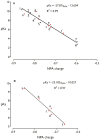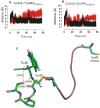How thioredoxin dissociates its mixed disulfide
- PMID: 19675666
- PMCID: PMC2714181
- DOI: 10.1371/journal.pcbi.1000461
How thioredoxin dissociates its mixed disulfide
Abstract
The dissociation mechanism of the thioredoxin (Trx) mixed disulfide complexes is unknown and has been debated for more than twenty years. Specifically, opposing arguments for the activation of the nucleophilic cysteine as a thiolate during the dissociation of the complex have been put forward. As a key model, the complex between Trx and its endogenous substrate, arsenate reductase (ArsC), was used. In this structure, a Cys29(Trx)-Cys89(ArsC) intermediate disulfide is formed by the nucleophilic attack of Cys29(Trx) on the exposed Cys82(ArsC)-Cys89(ArsC) in oxidized ArsC. With theoretical reactivity analysis, molecular dynamics simulations, and biochemical complex formation experiments with Cys-mutants, Trx mixed disulfide dissociation was studied. We observed that the conformational changes around the intermediate disulfide bring Cys32(Trx) in contact with Cys29(Trx). Cys32(Trx) is activated for its nucleophilic attack by hydrogen bonds, and Cys32(Trx) is found to be more reactive than Cys82(ArsC). Additionally, Cys32(Trx) directs its nucleophilic attack on the more susceptible Cys29(Trx) and not on Cys89(ArsC). This multidisciplinary approach provides fresh insights into a universal thiol/disulfide exchange reaction mechanism that results in reduced substrate and oxidized Trx.
Conflict of interest statement
The authors have declared that no competing interests exist.
Figures








Similar articles
-
Conformational fluctuations coupled to the thiol-disulfide transfer between thioredoxin and arsenate reductase in Bacillus subtilis.J Biol Chem. 2007 Apr 13;282(15):11078-83. doi: 10.1074/jbc.M700970200. Epub 2007 Feb 15. J Biol Chem. 2007. PMID: 17303556
-
Intra- and inter-protein couplings of backbone motions underlie protein thiol-disulfide exchange cascade.Sci Rep. 2018 Oct 18;8(1):15448. doi: 10.1038/s41598-018-33766-4. Sci Rep. 2018. PMID: 30337655 Free PMC article.
-
A Hybrid Mechanism for the Synechocystis Arsenate Reductase Revealed by Structural Snapshots during Arsenate Reduction.J Biol Chem. 2015 Sep 4;290(36):22262-73. doi: 10.1074/jbc.M115.659896. Epub 2015 Jul 29. J Biol Chem. 2015. PMID: 26224634 Free PMC article.
-
Thioredoxin structure and mechanism: conformational changes on oxidation of the active-site sulfhydryls to a disulfide.Structure. 1995 Mar 15;3(3):239-43. doi: 10.1016/s0969-2126(01)00153-8. Structure. 1995. PMID: 7788289 Review.
-
Conferring specificity in redox pathways by enzymatic thiol/disulfide exchange reactions.Free Radic Res. 2016;50(2):206-45. doi: 10.3109/10715762.2015.1120864. Free Radic Res. 2016. PMID: 26573728 Review.
Cited by
-
NrdH-redoxin of Mycobacterium tuberculosis and Corynebacterium glutamicum dimerizes at high protein concentration and exclusively receives electrons from thioredoxin reductase.J Biol Chem. 2013 Mar 15;288(11):7942-7955. doi: 10.1074/jbc.M112.392688. Epub 2013 Jan 28. J Biol Chem. 2013. PMID: 23362277 Free PMC article.
-
Protein flexibility and cysteine reactivity: influence of mobility on the H-bond network and effects on pKa prediction.Protein J. 2014 Aug;33(4):323-36. doi: 10.1007/s10930-014-9564-z. Protein J. 2014. PMID: 24809821
-
Effects of Environmental and Electric Perturbations on the pKa of Thioredoxin Cysteine 35: A Computational Study.Molecules. 2022 Sep 30;27(19):6454. doi: 10.3390/molecules27196454. Molecules. 2022. PMID: 36234991 Free PMC article.
-
The conserved active site tryptophan of thioredoxin has no effect on its redox properties.Protein Sci. 2010 Jan;19(1):190-4. doi: 10.1002/pro.269. Protein Sci. 2010. PMID: 19902501 Free PMC article.
-
Methylation of arsenic by recombinant human wild-type arsenic (+3 oxidation state) methyltransferase and its methionine 287 threonine (M287T) polymorph: Role of glutathione.Toxicol Appl Pharmacol. 2012 Oct 1;264(1):121-30. doi: 10.1016/j.taap.2012.07.024. Epub 2012 Jul 31. Toxicol Appl Pharmacol. 2012. PMID: 22868225 Free PMC article.
References
-
- Messens J, Van Molle I, Vanhaesebrouck P, Limbourg M, Van Belle K, et al. How thioredoxin can reduce a buried disulphide bond. J Mol Biol. 2004;339:527–537. - PubMed
-
- Aslund F, Berndt KD, Holmgren A. Redox potentials of glutaredoxins and other thiol-disulfide oxidoreductases of the thioredoxin superfamily determined by direct protein-protein redox equilibria. J Biol Chem. 1997;272:30780–30786. - PubMed
-
- Cheng Z, Arscott LD, Ballou DP, Williams CH., Jr. The relationship of the redox potentials of thioredoxin and thioredoxin reductase from Drosophila melanogaster to the enzymatic mechanism: reduced thioredoxin is the reductant of glutathione in Drosophila. Biochemistry. 2007;46:7875–7885. - PubMed
-
- Martin JL. Thioredoxin–a fold for all reasons. Structure. 1995;3:245–250. - PubMed
-
- Eklund H, Gleason FK, Holmgren A. Structural and functional relations among thioredoxins of different species. Proteins. 1991;11:13–28. - PubMed
Publication types
MeSH terms
Substances
LinkOut - more resources
Full Text Sources
Other Literature Sources
Research Materials

